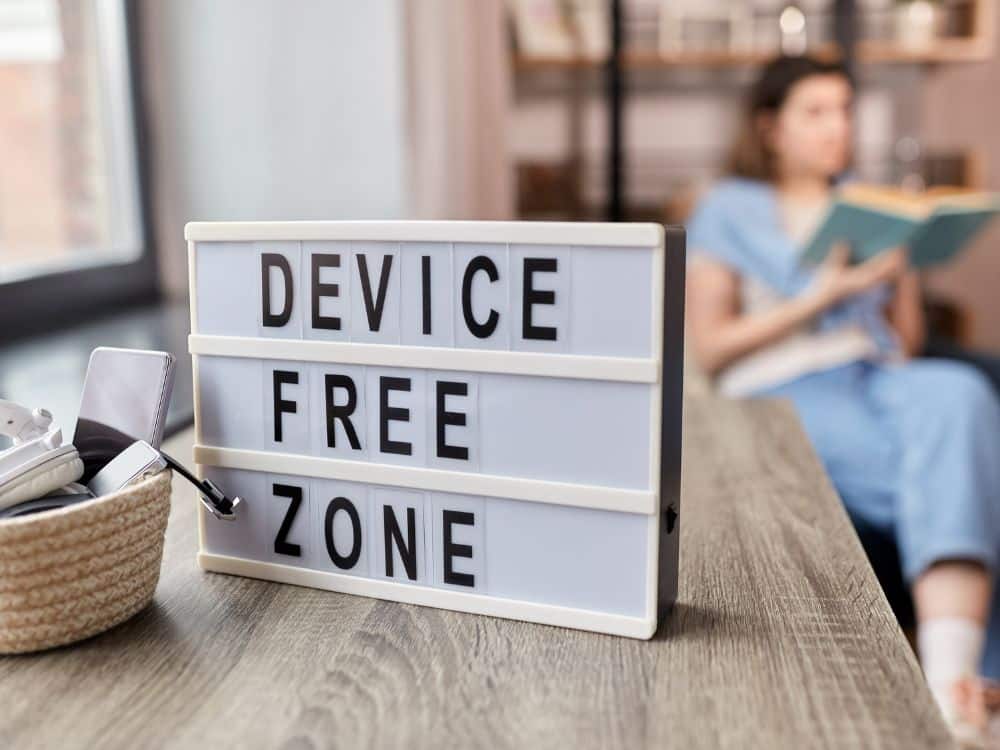In the hyper-connected tapestry of the 21st century, where smartphones are extensions of our hands and notifications constantly vie for our attention, the concept of tech-free zones has emerged not as a luxury, but as an essential practice for maintaining mental clarity, fostering genuine human connection, and boosting overall well-being. These designated spaces or periods, where digital devices are intentionally set aside, offer a vital respite from the relentless demands of the online world. For individuals grappling with digital overload, seeking enhanced focus, or yearning for more present interactions, understanding and implementing effective digital breaks is a transformative strategy. This growing realization of the need for disconnection makes “digital detox” and “tech-free living” trending search terms, providing significant potential for content creators to generate high Google AdSense revenue through insightful, practical, and actionable guidance. This comprehensive article will delve into the profound importance of carving out tech-free spaces, explore various practical strategies for achieving meaningful digital breaks, and illustrate how these seemingly simple acts of disconnection can profoundly boost your well-being, paving the way for a more balanced and fulfilling life in an increasingly digital age.
The Imperative of Disconnection: Why Tech-Free Zones Matter
Modern life is steeped in digital saturation. From the moment we wake to the glow of a phone screen to the last scroll before bed, our lives are interwoven with technology. While undoubtedly offering unparalleled convenience and access to information, this constant connectivity carries a significant hidden cost: diminished attention spans, increased anxiety, disrupted sleep patterns, and a pervasive sense of being overwhelmed. Tech-free zones serve as a crucial antidote, a deliberate act of reclaiming our focus and peace.
The critical importance of establishing digital breaks includes:
- Restoring Mental Clarity and Focus: Constant notifications and multi-tasking fragment our attention. Disconnecting allows the brain to declutter, process information, and rebuild its capacity for deep focus, significantly reducing mental fog and improving concentration.
- Reducing Stress and Anxiety: The fear of missing out (FOMO), the pressure to constantly perform, and exposure to negative news cycles contribute to chronic stress and anxiety. Digital breaks create a buffer, allowing the nervous system to calm down and reset.
- Enhancing Real-World Connections: When devices are put away, genuine face-to-face interactions flourish. This fosters deeper empathy, better communication, and strengthens personal relationships, which are fundamental to human well-being.
- Improving Sleep Quality: The blue light emitted by screens suppresses melatonin production, disrupting natural sleep cycles. Creating tech-free zones, especially before bedtime, promotes healthier sleep architecture and more restorative rest.
- Boosting Creativity and Problem-Solving: Our brains need downtime to consolidate information and make new connections. Digital breaks allow for “diffuse thinking,” sparking new ideas and innovative solutions that are often elusive in a state of constant stimulation.
- Fostering Self-Awareness and Mindfulness: Without digital distractions, we become more attuned to our internal states, thoughts, and emotions. This increased self-awareness is foundational for personal growth and emotional regulation.
- Reclaiming Time and Productivity: What feels like “checking in” often devolves into endless scrolling. Tech-free periods free up significant blocks of time that can be redirected toward meaningful activities, hobbies, and truly productive work.
- Protecting Privacy and Personal Space: By establishing boundaries with technology, we reinforce the idea that not every moment needs to be shared or tracked, safeguarding our personal boundaries.
Ultimately, embracing tech-free zones isn’t about rejecting technology; it’s about mastering it. It’s a strategic choice to wield digital tools with intentionality, ensuring they serve us rather than control us, leading to a more balanced, present, and fulfilling existence.
Pillars of Digital Disconnection: Crafting Your Tech-Free Life
Establishing effective tech-free zones requires a multi-faceted approach, incorporating deliberate practices into various aspects of daily life. These pillars provide a framework for integrating periods of disconnection seamlessly.
A. Designating Physical Tech-Free Spaces
Creating specific areas in your home or workplace where devices are off-limits can act as powerful visual cues for disconnection.
- The Bedroom as a Sanctuary: This is arguably the most crucial zone.
- No Screens Before Bed: Implement a strict “no screens” rule for at least 60-90 minutes before sleep. This includes phones, tablets, laptops, and even TVs.
- Charging Outside the Bedroom: Charge all devices in a common area or a designated spot outside the bedroom to eliminate the temptation of late-night or early-morning scrolling.
- Alarm Clock Alternatives: Use a traditional alarm clock instead of your phone to avoid bringing the device into your sleep space.
- Books Over Blue Light: Replace screen-based bedtime routines with reading a physical book, journaling, or listening to an audiobook or calming music.
- The Dining Area as a Connection Hub: The dining table should be a place for conversation and shared meals, free from digital interruption.
- Family Charging Station: Establish a “device basket” or charging station near the entry where all phones are deposited before meals.
- No Devices at the Table: Make it a non-negotiable rule for everyone present, setting an example for children.
- Engage in Conversation: Use meal times as opportunities for genuine conversation and presence.
- Dedicated Work Focus Zones: For those who work from home, defining a focused workspace without digital distractions is key.
- Designated Workstation: If possible, work in a specific room or corner that is solely for work.
- “Deep Work” Mode: When engaging in tasks requiring high concentration, put your phone on silent and out of sight, close unnecessary tabs, and consider using focus-enhancing apps that block distractions.
- Scheduled Breaks, Not Constant Checks: Instead of reacting to every notification, schedule specific times to check emails and messages.
B. Implementing Temporal Tech-Free Periods
Beyond physical spaces, setting specific times for digital breaks is vital for consistent disconnection.
- Morning and Evening Bookends: These are prime times for personal well-being.
- The First Hour Rule: Avoid checking your phone, email, or social media for the first hour after waking up. Use this time for mindfulness, exercise, or breakfast.
- The Last Hour Rule: Similarly, disconnect from all screens for the last hour before going to bed.
- Mealtime Mandates: Transform eating into a mindful, social, or reflective activity.
- Device-Free Meals: Whether dining alone or with others, make meals a time to savor food and engage in real-world interactions.
- No “Dinner-and-a-Show”: Resist the urge to eat in front of the TV or while scrolling on a device.
- Weekly Digital Sabbath: Dedicate an extended period, like a few hours or a full day each week, to be entirely tech-free.
- Plan Ahead: Inform friends and family that you’ll be offline.
- Plan Activities: Fill the time with non-digital hobbies, outdoor activities, or quality time with loved ones.
- Emergency Contact Method: Have a designated non-digital way for genuine emergencies (e.g., a landline, or a single emergency contact number known to close family).
- “Do Not Disturb” Intervals: Use your phone’s “Do Not Disturb” or “Focus Mode” features.
- During Meetings/Study: Activate DND to avoid interruptions.
- Personal Time: Use it during workouts, hobbies, or family time.
C. Cultivating Mindful Device Usage
It’s not just about disconnecting; it’s about being intentional when you are connected.
- Audit Your Screen Time: Most smartphones have built-in tools (Screen Time on iOS, Digital Wellbeing on Android) to track your usage. Understand where your time is going.
- Curate Your Notifications: Turn off all non-essential notifications. Only allow critical alerts from actual human contacts.
- Batch Notifications: Set specific times to check email and social media, rather than reacting to every ping.
- Disable Vibrate/Sound: Keep only visual cues if you must have some notifications.
- Delete Unnecessary Apps: Remove apps that are habitual time-wasters or cause anxiety (e.g., social media apps you compulsively check). Access them via a web browser if truly necessary.
- Practice Intentional Engagement: Before picking up your phone, ask yourself: “Why am I picking this up? What specific task do I need to accomplish?”
- Avoid “Phantom Buzzes”: Acknowledge the psychological urge to check your phone even when it hasn’t buzzed, and resist it.
- Use Apps as Tools, Not Masters: Remember that apps are designed to be addictive; use them for specific purposes then put them down.
- Charge Devices Away From Reach: When you’re in a tech-free zone, physically place your device out of arm’s reach to reduce unconscious grabbing.
D. Finding Analog Alternatives and Hobbies
Replacing screen time with enriching non-digital activities is key to sustainable digital breaks.
- Embrace Reading Physical Books: Reconnect with the tactile experience of paper pages.
- Engage in Creative Hobbies: Explore painting, drawing, knitting, playing a musical instrument, writing, or crafting.
- Spend Time Outdoors: Go for walks, hikes, gardening, or simply sit in nature.
- Cook and Bake: Enjoy the process of creating meals from scratch, a multi-sensory and fulfilling activity.
- Play Board Games or Card Games: Engage in face-to-face interaction and friendly competition.
- Pursue Physical Activities: Go for a run, swim, cycle, or join a local sports team.
- Journaling: Use a pen and paper to express thoughts and feelings, a powerful tool for self-reflection.
Advanced Strategies for Deep Digital Detoxification

For those looking to take their digital breaks to the next level, or to reset deeply ingrained habits, more intensive strategies can be profoundly effective.
A. Weekend Digital Detoxes
Dedicate an entire weekend, or at least a full 24-48 hours, to being completely offline.
- Pre-Plan and Inform: Let essential contacts know you’ll be unreachable for a period. Set an auto-reply for work emails.
- Prepare Offline Activities: Have a list of books, outdoor excursions, craft projects, or social plans ready.
- Remove Temptation: Store devices in a drawer or a different room that is not frequently accessed.
- Journal the Experience: Note how you feel, what challenges arise, and what benefits you observe.
B. “Dumb Phone” or Basic Phone Experiment
For those struggling with smartphone addiction, temporarily or permanently switching to a basic feature phone can be a radical reset.
- Eliminate Smart Features: These phones typically only allow calls and texts, removing social media, email, and endless Browse temptations.
- Focus on Core Communication: Relearn to use your phone purely as a communication tool.
- Observe Behavioral Shifts: Pay attention to how your habits and attention change when the constant digital pull is removed.
C. Tech-Free Vacations or Retreats
Choosing destinations or experiences specifically designed to be disconnected can provide a powerful reset.
- Remote Locations: Opt for places with limited or no Wi-Fi/cellular service.
- Digital Detox Retreats: Look for organized retreats that encourage or mandate digital disconnection.
- Communicate Expectations: Ensure travel companions are on board with the tech-free rule.
D. Implementing “Digital Rules” for Family and Households
Creating shared understanding and boundaries for technology use within a household fosters a healthier environment for everyone.
- Designated Charging Stations: A central spot for all devices overnight.
- No Phones at Dinner Rule: Enforced consistently.
- Family Screen Time Limits: Using parental controls or agreement-based limits for children and adults.
- Tech-Free Family Time: Designating specific evenings or weekend blocks for activities that don’t involve screens.
- Lead by Example: Adults must model the desired behavior.
The Benefits: How Digital Breaks Boost Well-Being
Consistently implementing tech-free zones and digital breaks yields a multitude of tangible benefits that significantly enhance overall well-being.
A. Improved Mental Health
- Reduced Anxiety and Depression: Less exposure to curated “perfect” lives on social media and constant news cycles can significantly alleviate feelings of inadequacy, comparison, and fear.
- Enhanced Focus and Attention Span: By minimizing constant context-switching, the brain’s ability to concentrate deeply on tasks improves, leading to better memory and problem-solving.
- Greater Calm and Reduced Stress: Disconnecting from digital noise allows the nervous system to shift from a state of hyper-arousal to one of rest and relaxation, lowering stress hormones like cortisol.
- Boosted Creativity: The brain needs downtime and “mind-wandering” to make novel connections and generate new ideas. Digital breaks provide this essential space for creative incubation.
B. Stronger Physical Health
- Better Sleep Quality: Eliminating blue light exposure before bed and the temptation of late-night scrolling promotes quicker sleep onset, deeper sleep cycles, and overall more restorative rest.
- Reduced Eye Strain and Headaches: Less screen time directly reduces strain on the eyes, mitigating symptoms like dry eyes, blurred vision, and tension headaches.
- Improved Posture: Less hunching over devices can alleviate neck and back pain.
- Increased Physical Activity: Time previously spent on screens is often redirected to outdoor activities, exercise, or movement, contributing to overall fitness.
C. Deeper Relationships and Social Connection
- Enhanced Communication: Face-to-face interactions are richer and more nuanced without digital interruptions. You become a better listener and conversationalist.
- Increased Empathy: Being fully present with others allows for greater understanding of their non-verbal cues and emotional states.
- Stronger Bonds: Shared experiences and undivided attention build more meaningful and resilient relationships with family, friends, and partners.
- Reduced Loneliness: Despite widespread connectivity, many feel isolated. Real-world interactions combat this isolation more effectively than digital ones.
D. Greater Productivity and Intentionality
- Focused Work Sessions: Eliminating digital distractions during work periods leads to higher quality output in less time.
- Reclaimed Time: You’ll be surprised how much time you free up when you’re not compulsively checking devices, which can then be used for hobbies, personal growth, or relaxation.
- Increased Self-Awareness: Without constant external stimulation, you become more attuned to your own needs, desires, and internal rhythm. This leads to more intentional choices about how you spend your time and energy.
The Future: Integrating Tech with Intentional Disconnection

The trajectory of technology suggests that our lives will become even more intertwined with digital tools. However, this also implies a growing and equally vital counter-movement: the conscious integration of tech-free zones and digital breaks as standard practice for a healthy life. The future of well-being isn’t about shunning technology entirely, but about cultivating a sophisticated awareness of its impact and employing intentional strategies to harness its benefits while mitigating its drawbacks.
This will likely manifest as:
- Smarter Devices with Built-in Boundaries: Technology itself will evolve to offer more robust “focus modes,” intelligent notification management, and AI-driven insights into our digital habits, empowering us to disconnect more easily.
- Architectural Design for Digital Retreats: Homes and workspaces might increasingly incorporate dedicated areas physically designed to be tech-free, with features that encourage analog activities.
- Societal Norms Shifting: It may become increasingly common and accepted to put phones away during social gatherings, meals, and family time, with less social pressure to be constantly available online.
- Educational Emphasis: Schools and workplaces will likely place greater emphasis on digital literacy that includes responsible usage, boundary setting, and the benefits of disconnection.
- Wellness Tourism Centered on Digital Detox: An expansion of retreats and travel experiences that market themselves specifically on providing a complete digital break.
Ultimately, mastering tech-free zones is an empowering act of self-leadership in the digital age. It’s the conscious decision to prioritize your well-being, clarity, and genuine connections above the fleeting allure of constant digital stimulation. By consistently integrating these powerful digital breaks into your routine, you are not just managing technology; you are actively shaping a life that is more balanced, more present, and deeply fulfilling, providing an invaluable blueprint for anyone seeking to thrive in our increasingly connected world.











